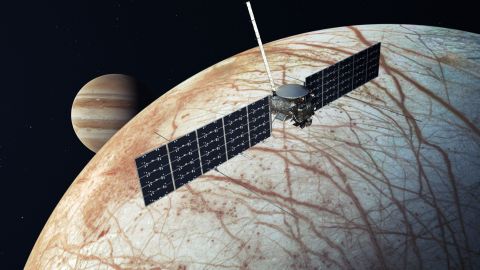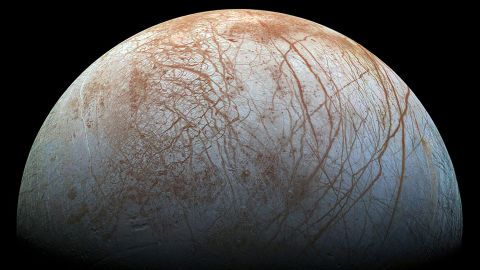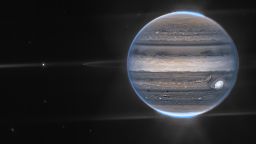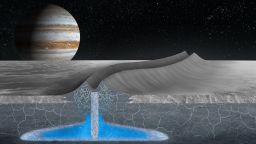Sign up for CNN’s Wonder Theory science newsletter. Explore the universe with news on fascinating discoveries, scientific advancements and more.
A NASA spacecraft will fly by one of the most intriguing ocean worlds in our solar system on Thursday.
The Juno spacecraft, which has been orbiting Jupiter since 2016, was scheduled to make its closest approach yet to the moon Europa at 5:36 a.m. ET, flying within 222 miles (358 kilometers) of its icy surface.
Juno will capture some of the highest resolution images ever taken of Europa’s ice shell. The spacecraft also is expected to gather data about the moon’s interior, where a salty ocean is thought to exist.
The ice shell that makes up the moon’s surface is between 10 and 15 miles (16 and 24 kilometers) thick, and the ocean it likely sits on top of is estimated to be 40 to 100 miles (64 to 161 kilometers) deep.
Juno’s Microwave Radiometer instrument will study the ice crust to determine more about its temperature and composition. It’s the first time this kind of information will be collected about Europa’s frozen shell.
The data and images captured by Juno could help inform NASA’s Europa Clipper mission, which will launch in 2024 to perform a dedicated series of 50 flybys around the moon after arriving in 2030. Europa Clipper may be able to help scientists determine whether the interior ocean exists and if the moon — one of many orbiting Jupiter — has the potential to be habitable for life.

Clipper will eventually transition from an altitude of 1,700 miles (2,735 kilometers) to just 16 miles (26 kilometers) above the moon’s surface. While Juno has largely focused on studying Jupiter, Clipper will be dedicated to observing Europa.
“Europa is such an intriguing Jovian moon, it is the focus of its own future NASA mission,” said Scott Bolton, Juno principal investigator at the Southwest Research Institute in San Antonio in a statement.
“We’re happy to provide data that may help the Europa Clipper team with mission planning, as well as provide new scientific insights into this icy world.”
All of Juno’s instruments will be collecting data during the flyby, including those that can measure the top layers of Europa’s atmosphere and how Europa interacts with Jupiter’s magnetic field. The team is hoping to spot a water plume rising up from cracks in the ice shell. Previous missions have spied plumes of water vapor erupting into space through the ice shell.
INTERACTIVE: Explore where the search for life is unfolding in our solar system
“We have the right equipment to do the job, but to capture a plume will require a lot of luck,” Bolton said. “We have to be at the right place at just the right time, but if we are so fortunate, it’s a home run for sure.”
Images taken of Europa during the flyby can be compared with those taken by previous missions to study how the moon’s surface might have changed over the last 20 years.
Europa is about 90% of the size of Earth’s moon, and Juno’s flyby will be the closest a NASA spacecraft has come to it since the Galileo mission flew by in 2000.
Juno is in the extended part of its mission, which was set to end in 2021. The spacecraft is now focused on performing flybys of some of Jupiter’s moons. The spacecraft visited Ganymede in 2021 and will zoom by Io in 2023 and 2024. Its mission is now set to end in 2025.
The Europa maneuver will also shorten Juno’s orbit around Jupiter from 43 to 38 days.

“The relative velocity between spacecraft and moon will be 14.7 miles per second (23.6 kilometers per second), so we are screaming by pretty fast,” said John Bordi, Juno deputy mission manager at NASA’s Jet Propulsion Laboratory in Pasadena, California, in a statement.
“All steps have to go like clockwork to successfully acquire our planned data, because soon after the flyby is complete, the spacecraft needs to be reoriented for our upcoming close approach of Jupiter, which happens only 7½ hours later.”
Article From & Read More ( NASA spacecraft will fly by an ocean world orbiting Jupiter - CNN )https://ift.tt/4lBkpdr
Science



No comments:
Post a Comment